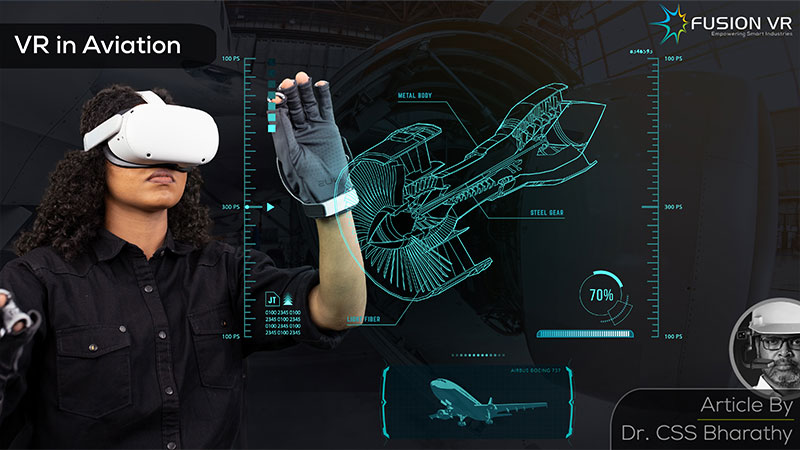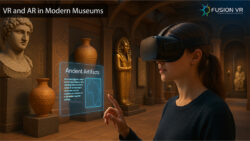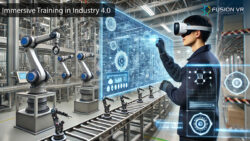The COVID-19 pandemic did bring the aviation industry to its knees, particularly the commercial airline companies. Many countries locked down and made it impossible for people to travel anywhere. Fortunately, vaccination has brought down new infections and also it safer for people to travel again. The industry has survived and is poised to grow again.
The European multi-national aerospace company, Airbus, forecasts a demand for 39,000 aircraft in the next 20 years to replace ageing fleets and also meet growing needs. There is obviously a need for well-trained and competent personnel to operate and maintain these aircraft. It is extremely crucial for the industry leaders to develop the foresight to identify future challenges and tackle them with the aid of new technologies.
Virtual Reality or VR is one such technology that has extensive potential for the aviation industry of the future. VR is one of the coolest immersive technologies that sets out to enhance human competencies and performance like never before. VR technology and services have grown by leaps and bounds, making them more accessible and affordable to companies and individual users.
As an industry expert, it is my pleasure to share with you how VR is making a difference around the world to create and maintain competitive advantages for companies. The magic of VR is that it enables you to explore and perform things you once imagined were never possible or affordable. The great advances in computing and communications technologies have made the impossible possible!
Benefits of Virtual Reality Training for Aviation Personnel
Virtual reality in aviation training is a game changer for training all personnel engaged in operations, maintenance, reliability, cabin duties, safety, emergency response, customer care etc. VR provides not good training but great training! VR training is four times faster, increases confidence and delivers greater retention, according to a study by PWC. Many corporations and agencies have begun incorporating Virtual reality training as part of their aviation training programs and integrating its results into existing learning management systems.
The first ever certificate for a VR-based flight simulation training device has been granted by EASA, the European Union Aviation Safety Agency. These devices are designed to help train experienced pilots and students to gain competence in basic flight and emergency skills.
The trainee is immersed in a fully functional VR cockpit with all the controls that are in a real helicopter. This certification is a major landmark, and recognition for VR flight training as the training credit received by students adds up to the necessary training hours for a flying license.
In addition to that, Air France has co-developed a standalone VR Engine Run-Up training solution that is designed to enhance training in operations and maintenance of engines. This VR aviation training solution has led to reduced time spent on flight simulator practice and rendered the overall sequence of training more effective.
VR for pilot training has more advanced uses, such as training them to recognize and manage optical illusions that affect pilots, in particular the runway width illusion. As pilots descend on a runway that is somewhat narrower than normal, it creates an illusion that the aeroplane is higher than it actually is, making the pilot take a lower approach than necessary.
Similarly, if the runway is wider than normal, the pilot experiences an illusion that he is lower than he actually is and makes him take a higher approach than needed.
Adoption of VR Training in the Aircraft Industry
Such illusions affect judgment which has serious risks while landing with a plane load of passengers, which is usually the norm. VR simulator training is designed to be repetitive without incurring additional costs, and devices such as the Virtual Reality Aviation Illusion Trainer actually help pilots better prepare themselves for these types of situations.
VR training solutions also have operational uses for airline companies which place a heavy emphasis on training standards and compliance. With the rapid growth of air travel, there is an ever-increasing need for well-trained pilots. Older pilots are retained to support training and operational needs.
However, there are some risks with older pilots such as declining health and their ability to recognize and respond to critical situations. Such VR aviation training solutions are employed for cognitive health screening and validation of pilot readiness for continued operational engagements.
VR training is not just limited to pilots in the aviation industry. Cabin crew training can also be accomplished with VR as they play a crucial role in the effective operation of all aircraft. They are no longer air hostesses as we used to refer to in the past. The cabin crew perform multiple operational, safety, security and emergency roles.
They are always the first responders and need to communicate effectively to passengers and cockpit crew in emergency situations. VR training is geared to develop competencies for cabin crew in all these areas in a virtual 3D cabin crew environment with virtual passengers.
Role play and what-if scenarios are developed to test and certify the required competencies. Such training leaves the crew ingrained with the desired responses that become evident in real flight operations. Excellent service is always noticed by customers which eventually enhances the airline’s reputation.
Now is the time for all aircraft manufacturing and operating companies to rapidly adopt VR training for their personnel. As VR is new in the professional airlines world, companies need the assistance of established VR solutions providers to provide the perspective and guidance to identify the pain points and appropriate use cases and develop tailor-made solutions that have a clear result on their operating efficiency and bottom line.





